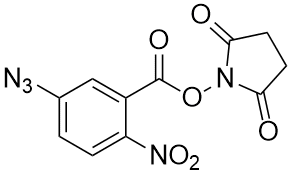N-(5-Azido-2-nitrobenzoyloxy)succinimide is widely utilized in research focused on:
- Bioconjugation: This compound serves as an effective linker in bioconjugation processes, allowing researchers to attach biomolecules like proteins or antibodies to surfaces or other molecules, enhancing the development of targeted therapies.
- Drug Development: It plays a crucial role in the pharmaceutical industry for synthesizing novel drug candidates, particularly in creating compounds with improved efficacy and specificity for disease targets.
- Photochemistry: The azido group enables light-induced reactions, making it valuable in photochemical studies and applications, such as the development of light-activated drug delivery systems.
- Diagnostics: It is used in the creation of diagnostic tools, including biosensors, where its ability to selectively bind to specific biomolecules can enhance detection methods for various diseases.
- Polymer Chemistry: This compound is utilized in polymer synthesis, particularly in creating functionalized polymers that can be used in drug delivery systems or as scaffolds in tissue engineering.
General Information
Properties
Safety and Regulations
Applications
N-(5-Azido-2-nitrobenzoyloxy)succinimide is widely utilized in research focused on:
- Bioconjugation: This compound serves as an effective linker in bioconjugation processes, allowing researchers to attach biomolecules like proteins or antibodies to surfaces or other molecules, enhancing the development of targeted therapies.
- Drug Development: It plays a crucial role in the pharmaceutical industry for synthesizing novel drug candidates, particularly in creating compounds with improved efficacy and specificity for disease targets.
- Photochemistry: The azido group enables light-induced reactions, making it valuable in photochemical studies and applications, such as the development of light-activated drug delivery systems.
- Diagnostics: It is used in the creation of diagnostic tools, including biosensors, where its ability to selectively bind to specific biomolecules can enhance detection methods for various diseases.
- Polymer Chemistry: This compound is utilized in polymer synthesis, particularly in creating functionalized polymers that can be used in drug delivery systems or as scaffolds in tissue engineering.
Documents
Safety Data Sheets (SDS)
The SDS provides comprehensive safety information on handling, storage, and disposal of the product.
Product Specification (PS)
The PS provides a comprehensive breakdown of the product’s properties, including chemical composition, physical state, purity, and storage requirements. It also details acceptable quality ranges and the product's intended applications.
Certificates of Analysis (COA)
Search for Certificates of Analysis (COA) by entering the products Lot Number. Lot and Batch Numbers can be found on a product’s label following the words ‘Lot’ or ‘Batch’.
Numéro de catalogue
Numéro de lot/série
Certificates Of Origin (COO)
This COO confirms the country where the product was manufactured, and also details the materials and components used in it and whether it is derived from natural, synthetic, or other specific sources. This certificate may be required for customs, trade, and regulatory compliance.
Numéro de catalogue
Numéro de lot/série
Safety Data Sheets (SDS)
The SDS provides comprehensive safety information on handling, storage, and disposal of the product.
DownloadProduct Specification (PS)
The PS provides a comprehensive breakdown of the product’s properties, including chemical composition, physical state, purity, and storage requirements. It also details acceptable quality ranges and the product's intended applications.
DownloadCertificates of Analysis (COA)
Search for Certificates of Analysis (COA) by entering the products Lot Number. Lot and Batch Numbers can be found on a product’s label following the words ‘Lot’ or ‘Batch’.
Numéro de catalogue
Numéro de lot/série
Certificates Of Origin (COO)
This COO confirms the country where the product was manufactured, and also details the materials and components used in it and whether it is derived from natural, synthetic, or other specific sources. This certificate may be required for customs, trade, and regulatory compliance.


